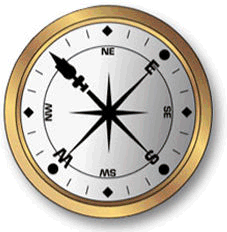Sarangbang (Sarang-bang,
Sarang Chae, Anchae)
Korean Men´s and women´s quarters
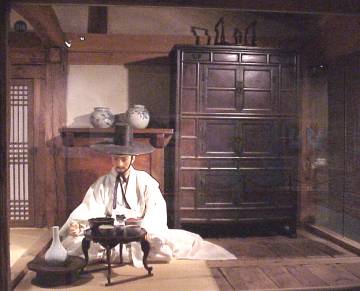
(Sarang-Bang with Book chest and Rice chest, National Museum Seoul)
A mattress, seat cushions with a back, various other cushions, long pillows, a folding screen, reading-writing table, stationery chest of drawers, table for stationery items, writing brush holder, paper holder, ink-stone and ink-sticks, letter rack, wardrobe chest, hat case and smoking set were usually found in a sarangbang.
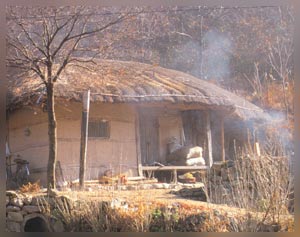
The backyard is often used as the most private outdoor space. In case of the small house, first the Servants' Building and next the Men's Building is omitted. However, the Men's Room (Sarang-bang) of the Men's Building is often sustained by being attached at the barn.
If the house size gets smaller than that, the house has the organization of 'inner building + barn' which is regarded as the minimal size. The house is demarcated by placing the outer walls of buildings at the boundary of the lot, or by building fences made of brushwood, stone, or mud and the like. In this way, the house usually has the definite boundary, which is deemed to be complement of the relatively open buildings.
In the traditional gentry's home of the past, the master's quarter was built close the main gate, and the housewife's quarter, called anchae , was deep inside garden. In less formal commoner's house, anchae was close to the kitchen and the husband's room was across from the anchae with wood-floored hall between them.
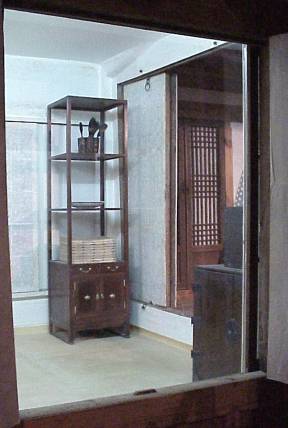 (Book Shelf (Tak-Jae) with drawing tools and pencils, National Museum Seoul) |
It was in sarang chae that the master of the house received guests and conducted
conversation on politics, arts, and various disciplines of learning. He read, painted, did calligraphy, composed poems, and meditated in this quarter.
Accordingly, the furniture and other artifacts of the sarang chae were designed to enhance this sense of
tranquility, sincerity, stability, and simplicity. The wood furniture pieces in sarang chae had simple lines, pleasing proportions, and stable structure. Tak-jae were considered the most important piece of furniture in the men's quarter. This furniture comes with a flat top and a lot of open space. The shelves used to hold books, flower vases, and incense bottles. Two of these shelves are frequently used together. This furniture is quite masculine in both usage and the implied design of its strong characteristics. The space between the shelf even allows to display large items. Picture books, photo albums and chinaware can be beautifully presented |
The Korean wood furniture
in the Sarang-Bang
The Korean wood furniture is essentially the product of Korea's floor-living culture as contrasted with chair-living culture of west and China. Korean furniture's proportion, and purpose were dictated by those of the Korean gentry's homes. These were structures of small rooms and low ceilings, necessitated by a heating system
(ondol) that warmed only the floor. The furniture pieces meant for the center of a room were made easy to relocate in order to ensure a maximum use of limited room space.
Korean furniture with low height was made to harmonize with walls and other furniture pieces of the room. The other important factor influencing the proportion, dimension, and the purpose of Korean wood furniture was the separated quarters for male and female members of the family. This strict Confucian separation resulted in subtle differences in the furnishing of the two quarters.
Wood furniture pieces in sarang chae may include such stationery related items as low writing table, document chest,
multy-shelf book chest, two-shelf book chest, and ink-stone set table. Royal paulownia and pine were used most often for the furniture pieces in the master's quarter.
Anchae
| While Korean women of the
Joseon period (1392-1910) were strictly restricted even in going out and placed under strict social rules and moral precepts guiding their
behavior, they could build their world within the home. |
|
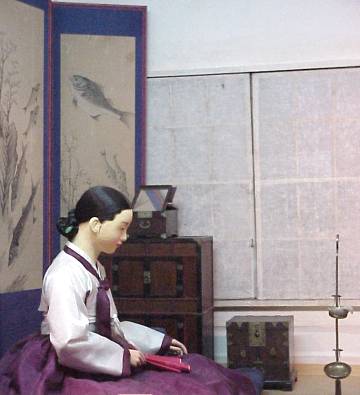 Anhae with end table, mirrorbox and painted screen, National Museum Seoul) |
Anchae was a comfortable place for rearing of children and conducting family life. Accordingly, furnishing for the women's quarter were warm, brightly
colored, and essentially feminine. Wood materials with beautiful grains like zelkova and persimmon were extensively used for furniture in anchae to produce nature-like atmosphere. |
Since Korea has four distinct seasons, two-or three- shelf clothing chests (Cheung-Jang), separable clothing chests, chest for Korean women's cotton-lined socks, and wardrobes were necessary to keep many clothes for different seasons with big difference in their temperatures. Headside chest, cases, and boxes were also placed in the room.
